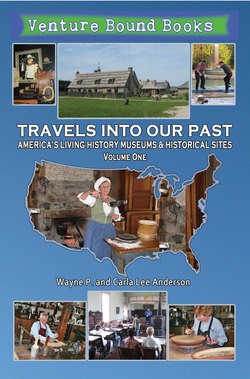Читать книгу Travels Into Our Past: America's Living History Museums & Historical Sites - Wayne P. Anderson - Страница 15
9. Moss-Adorned History Savannah, Georgia
ОглавлениеSavannah joins our list of world-class gem cities along with cities such as Heidelberg, Germany; Kyoto, Japan; Edinburgh, Scotland; and St. Augustine, Florida. Each is a perfect example of whatever it should be.
What we found in Savannah was a historic American city with beautifully restored structures, making the whole area a living museum.
At least three companies run tour trolleys that let riders get on and off at 15 stops as often they like during the day. The first day there we parked our car at the visitors’ center, and we used the trolleys. The drivers are also the guides, commenting on what we were seeing and telling stories about former famous and infamous citizens.
There was so much information about the history of the city and the sites we were passing that after the fourth stop, the information was sliding across our memory banks. We took several rides through some sections of the city and found that although some of the information was the same, the drivers used different approaches in their narrations.
In 1733, Gen. James Oglethorpe brought a select group of settlers to found Savannah, which was to be England’s 13th and final colony. Oglethorpe and a Col. William Bull laid out the new settlement in a series of 24 public squares, 21 of which still exist today. The commercial and residential buildings were arranged around these squares, which are unusually striking with their giant oaks, fountains and statues.
A guide on one of our walking tours noted that Savannians are a contrary lot; they have placed four statues of noted people in squares and then named a different square after them.
In each square we crossed, the oak trees were heavy with hanging Spanish moss. We were told that the origin of the phrase “Sleep tight, don’t let the bedbugs bite” originated from the fact that the mosses, filled with chiggers, were used for bedding.
All of the trolley drivers pointed out the square that was the setting for a scene in Forrest Gump where a feather comes off the steeple of a nearby church and drifts down to where he is sitting on a bench and introducing himself to a lady. The site of the bench is now a local museum. Several of the trolley drivers gave some very good imitations of actor Tom Hanks’ speech patterns in that role.
We took the river walk, which allowed us to get glimpses of one of the most active ports in the United States; only New York handles more products. Several giant ships were coming up the river as we walked. The street facing the walk consists of fourand five-story commercial buildings that looked to us much like those we remember seeing along the canals in Amsterdam, Netherlands.
Shops and cafes line the street levels of the buildings. Among the monuments along the way were the waving girl the city is so proud of, a black family, and the yacht race flame holder from the 1996 Olympics. Older men with their fishing poles stood along the way, but we saw only very small fish being caught.
One of our guides made much of the area where pirates hung out, an area that includes the oldest standing house in Georgia. This is also the area where men’s drinks were drugged before they were carried through an underground tunnel to waiting ships to serve as involuntary sailors. One man took three years to work his way back to Savannah.
America’s history is in a capsule here, from our founding through the Revolutionary War, our early growth as a commercial center, the Civil War and much activity connected to World War II. We spent three days here, and although we kept moving, we did not have time to tour more than a few of the many stately houses and museums that exist in this incredible city.
